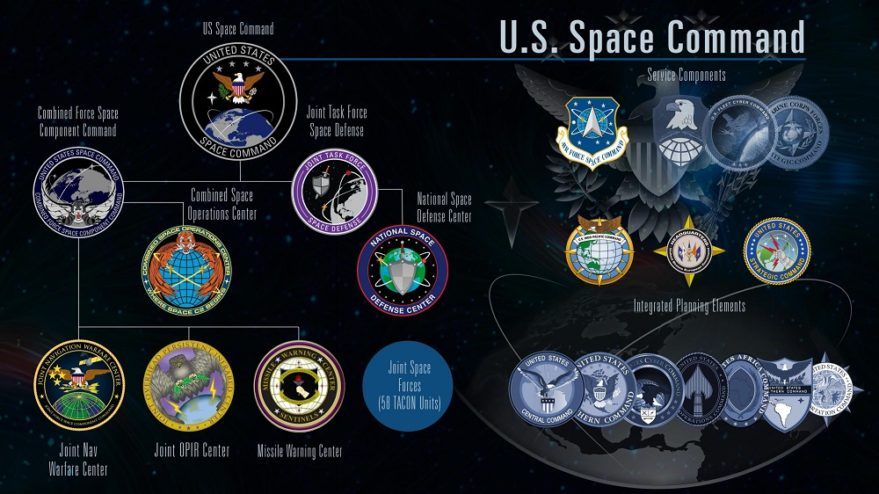New SPACECOM Strategy Warns US Adversaries
Article by Rachel S. Cohen February 1, 2021 (airforcemag.com)
• In August 2019, the US Space Command, or ‘SPACECOM’, was revived after being disbanded for 17 years, integrating its work with the other combatant commands that rely on and defend space assets. During a recent AFA Mitchell Institute for Aerospace Studies event, SPACECOM boss Gen. James H. Dickinson said that the US Space Command must “sustain a warfighting culture and adapt to a dynamic and changing strategic environment,” drawing upon the experience of the other armed forces.
• On February 1st, SPACECOM released a new strategy paper that broadly outlines goals for training, partnerships, and cybersecurity. But in a future with “increasingly capable competitors” and a “long-term security threat” posed by Russia and China, the paper also warns that the United States will hit back if its satellites, radars, and other space systems are endangered.
• As America and its allies expand their space economies and look to permanently return to the Moon, “[the] United States Space Command will always remain ready to prevail against any foreign space-related aggression” reads the strategy paper. “By developing…counter-space capabilities and…military doctrines to extend into space, our [Russian and Chinese] competitors seek to prevent our unfettered access to space and deny our freedom to operate in space.”
• The US military argues it needs to bolster its offense and defense in space to protect the satellites and radars that enable GPS guidance, ATMs, ballistic missile warning, and more. SPACECOM also uses those assets to direct weapons and troops, send information around the world, and collect intelligence—making them targets for those who want to disrupt American military operations.
• Brian Weeden, a director at the Secure World Foundation, says that the 12-page paper, comprised largely of pictures, lacks the detail of previous Pentagon strategy papers. “It reads more like an ad brochure full of chest-thumping assertions than a serious strategic document,” quipped Weeden.
• Weeden recognizes that the military may not be comfortable with publicly discussing developing space operations, and that the fact that there haven’t been any actual space battles, would explain the lack of sophistication for space doctrine relative to the other combat domains.
• Dickinson maintains that job one for SPACECOM is to attract the kind of veteran military talent who can bring various combat experiences to SPACECOM to develop a fully operational combatant command. “That generates combat power almost immediately.”

U.S. Space Command in its new strategy paper warns of a future with “increasingly capable competitors” and a “long-term security threat” posed by Russia and China, claiming the right of self-defense as America and its allies expand their space economies and look to permanently return to the moon.
posed by Russia and China, claiming the right of self-defense as America and its allies expand their space economies and look to permanently return to the moon.
The U.S. military argues it needs to bolster its offense and defense in space to protect the satellites and radars that enable GPS guidance, ATMs, ballistic missile warning, and more. SPACECOM also uses those assets to direct weapons and troops, send information around the world, and collect intelligence—making them targets for those who want to disrupt American military operations.
“By developing, testing, and deploying counter-space capabilities and evolving their military doctrines to extend into space, our competitors seek to prevent our unfettered access to space and deny our freedom to operate in space,” reads the paper, dated Feb. 1.
This is the latest document to warn that the United States will hit back if its satellites, radars, and other space systems are endangered. It also broadly outlines goals for training, partnerships, and cybersecurity. SpaceNews first reported on the strategic vision Jan. 28.
“The United States, along with our allies and partners, will champion and promote the responsible, peaceful, and safe use of space,” according to the strategy. “However, should our nation call, United States Space Command will always remain ready to prevail against any foreign space-related aggression.”

The document echoes earlier blueprints from the Pentagon and the Space Force, the branch of the military that supplies most systems and personnel to SPACECOM for daily operations. But the 12-page paper, comprised largely of pictures, lacks the detail of previous strategies.
“It reads more like an ad brochure full of chest-thumping assertions than a serious strategic document,” Brian Weeden, director of program planning at the Secure World Foundation, said on Twitter.
He suggested the strategy may miss the mark because the military is not yet comfortable with discussing often-classified space operations in a public forum.
“There is something to be said about the lack of sophistication for space doctrine relative to the other domains because we haven’t had any actual combat in space to draw on,” he told Air Force Magazine.
FAIR USE NOTICE: This page contains copyrighted material the use of which has not been specifically authorized by the copyright owner. ExoNews.org distributes this material for the purpose of news reporting, educational research, comment and criticism, constituting Fair Use under 17 U.S.C § 107. Please contact the Editor at ExoNews with any copyright issue.




